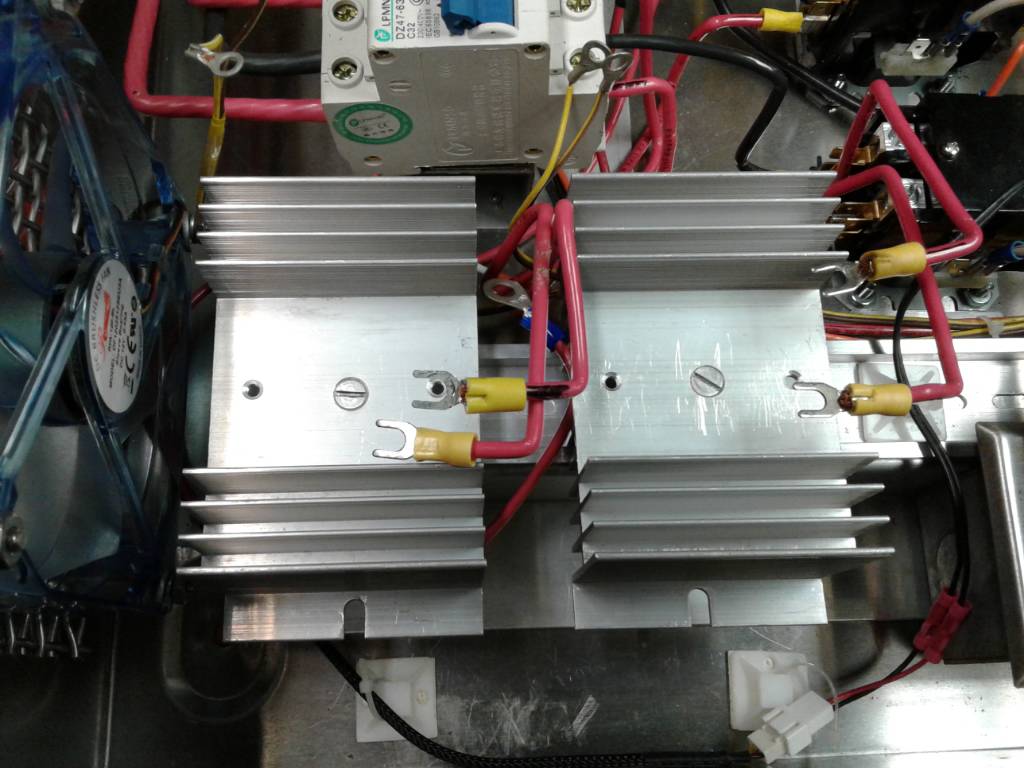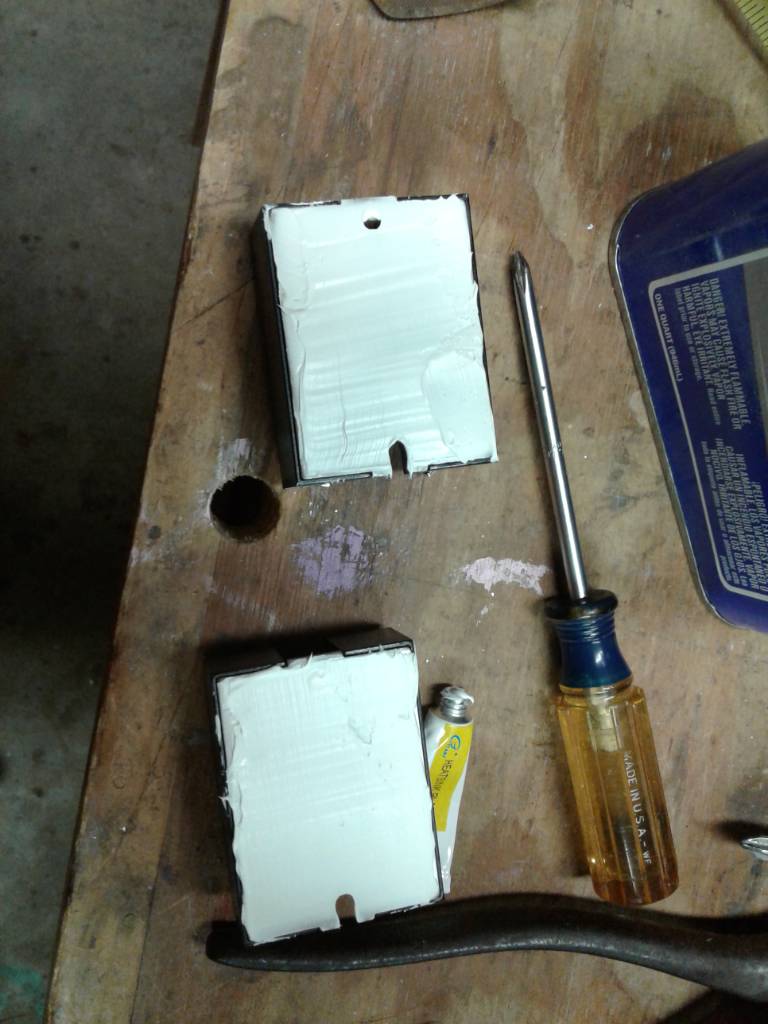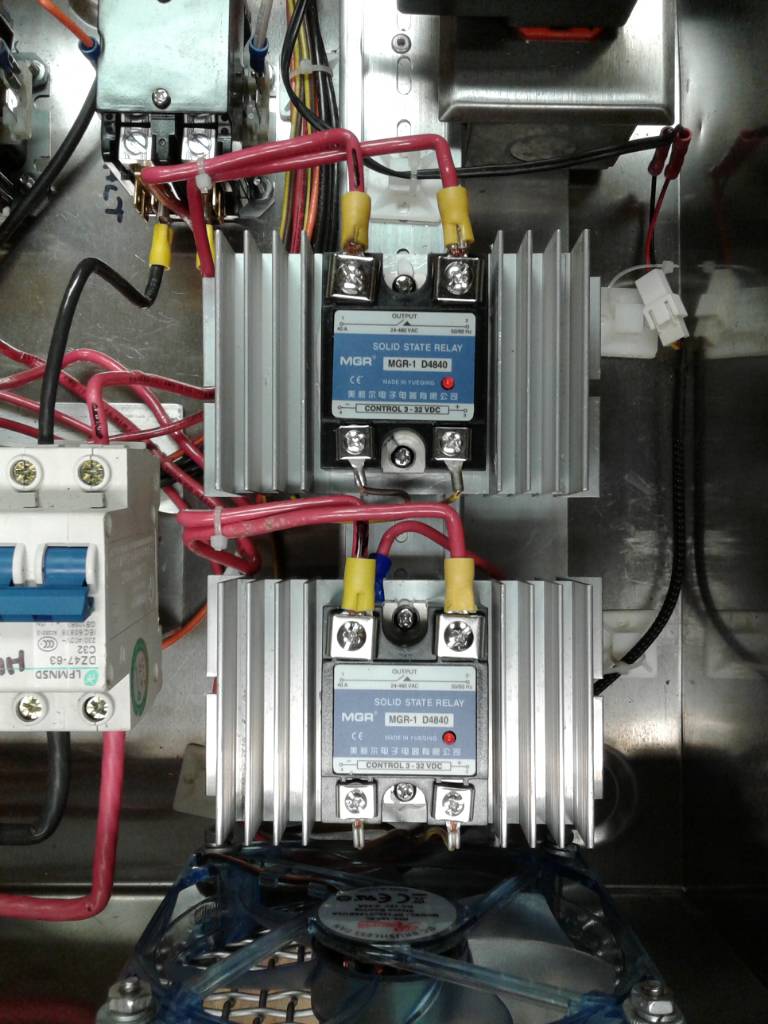augiedoggy
Well-Known Member
Exactly! if its not enough mass the heat builds up in whats there! It doesnt just not exist (unless its being efficiently dissipated) ... What your implying makes no sense here.Physics. Mass dissipates heat.

Exactly! if its not enough mass the heat builds up in whats there! It doesnt just not exist (unless its being efficiently dissipated) ... What your implying makes no sense here.Physics. Mass dissipates heat.
you know those "berme knockoffs" aren't knockoffs right? They are made on the same assy line as the mgr and auberin SSRs.. A fan makes all the difference in cooling... This is why all CPU's use fans on the heatsinks..Yeah. Horse is dead. But at the risk of belaboring, here's a temp reading on a knockoff Berme 40a SSR running a 5500w element at 100%. It peaks at about 135 deg F. If your heat sink is cool to the touch, you have a magical heat sink.
Yeah. Horse is dead. But at the risk of belaboring, here's a temp reading on a knockoff Berme 40a SSR running a 5500w element at 100%. It peaks at about 135 deg F. If your heat sink is cool to the touch, you have a magical heat sink.

I went though endless Foteks and they were all fake and fried or never worked. I bought some Crydoms on Ebay for cheap. Still going after a year. That would be my suggestionWhen I get my replacement SSR's, I'm going to tear that Fotek apart, and I bet I'll find a much lower rated TRIAK? And I'm not a betting kind of guy!



![Craft A Brew - Safale S-04 Dry Yeast - Fermentis - English Ale Dry Yeast - For English and American Ales and Hard Apple Ciders - Ingredients for Home Brewing - Beer Making Supplies - [1 Pack]](https://m.media-amazon.com/images/I/41fVGNh6JfL._SL500_.jpg)












I do have what appears to be just about that same heat sink mounted on a rims+biab panel I made with a 40a ssr and an ssvr mounted to it and To be honest it gets much hotter than my my main control panel heat sinks because there is no fan to cool it. I actually havent decided if I'm going to replace it or not because I dont like how hot it gets compared to the cheaper heat sink and fan setups mounted inside my other two panels.Yeah. Horse is dead. But at the risk of belaboring, here's a temp reading on a knockoff Berme 40a SSR running a 5500w element at 100%. It peaks at about 135 deg F. If your heat sink is cool to the touch, you have a magical heat sink.
I went though endless Foteks and they were all fake and fried or never worked. I bought some Crydoms on Ebay for cheap. Still going after a year. That would be my suggestion
Heres a picture of one of the melted Foteks I cracked open. Maybe the numbers will mean something to you?
https://www.homebrewtalk.com/forum/threads/numbers-inside-a-melted-ssr-pic.592756/
I would have to agree with this.. The only reason I still have a few foteks kicking around is I bought them for my first panel build or they came with pics I bought back then and they all still work fine.. I was lucky.I run a very large heat sink that sits right on top of my 50a panel. It get's pretty hot during the boil. It get's close to 100 degrees for sure. When I have both elements running it's over 110 degrees for sure. If you touch it you know it's hot. Those heat sinks may not be the best choice for a 60A panel but should be adequate depending on good surface contact and thermal paste. Especially with a fan to help cool.
After doing the research for my panel build. I would never buy a Fotek SSR even if the Pope himself was selling them. The net has thousands of stories about fakes coming from very reputable electronics supply chains. There are way to many SSRs out there that have zero reported fakes. They are only a dollar or two more.
Heatsinks get hot because they do an inadequate job of transferring heat to the air in the configuration in which they are used. The thermal conduction of the heatsink only affects how well heat gets from the component being cooled out to the fins, which is were most of the heat transfer to the air occurs. Even with low thermal conductivity, a heatsink would get hot if it didn't transfer heat well to the surrounding air.Those cheap heat sinks don't get warm to the touch, because they don't conduct heat..... The fans are just Blowing warm air around inside of that box. Best of luck.
Mass does not dissipate heat. Mass absorbs heat, analogous to how a capacitor absorbs electric charge. The purpose of a heatsink is not to absorb heat, but rather to conduct heat away from a source and transfer that heat to the surrounding air. The fact that your heatsink gets hot means that it is not transferring heat efficiently to the surrounding air. It has nothing to do with the mass of your heatsink. The cooler your heatsink, the better job it is doing of getting rid of the heat transferred to it by the heat source. A poor thermal interface reduces the amount of heat the gets transferred from the source to the heatsink, resulting in a hotter source.Physics. Mass dissipates heat. Weight one of those $2 Tee shaped heatsinks. I used some of them for a long time too. Until I switched to a real heat sink. My real heat sinks get hotter than hell. Because they are dissipating heat. But hey, whatever works. It's not like we're operating nuclear powerplants. It's just beer.

say that first sentence out loud ... Does that make any practical sense? The official rating of the device already has this buffer built in.
Again many fake fotek SSRs use components designed for only 10 amp regardless... A real 25amp rated device is rated to be used for up to 25amps that includes 23 amps... If it makes you feel better to use 40 amp equipment for 23 amps great but it isn't needed unless the products your using aren't properly designed.
The NEC 80% rule everyone here keeps misquoting if for devices that draw 100% sustained loads for over 3 hours continuous.
The truth is we are all discussing this without even knowing how the SSR was being cooled
Yeah there's a lot of scenarios and stipulations in the rulebook. That and the rulebook is always changing.Yeah that first sentence was bad, sorry. I never said it made sense to me, that was just the way it was explained to me by the facilities manager who had an associates in EET. I'm a horticulturalist not a electrician. I guess the NEC 80% rule made sense for the lights being ran for 16-18 hours.
Yep. Placing the heatsink on the side of the box, as you have done, will improve natural convection significantly. I'm not sure who started the trend of putting heatsinks on top of enclosures, but people seem to follow that lead blindly. It's not optimal for natural convection, but it does work well enough in most instances.My heatsink is setup on the side on the side of the box with the ribs facing up and down to form a draft. I can hold my hand 3 inches above the top of the heatsink and feel the hot air coming off it.
It gets piping hot at times. My last brew day I put the box near my front door and opened the door just a crack. Just the small draft from the door instantly cooled the heatsink from to hot to touch to luke warm. A small amount of movement goes a long way.

I run a very large heat sink that sits right on top of my 50a panel. It get's pretty hot during the boil. It get's close to 100 degrees for sure. When I have both elements running it's over 110 degrees for sure. If you touch it you know it's hot. Those heat sinks may not be the best choice for a 60A panel but should be adequate depending on good surface contact and thermal paste. Especially with a fan to help cool.
After doing the research for my panel build. I would never buy a Fotek SSR even if the Pope himself was selling them. The net has thousands of stories about fakes coming from very reputable electronics supply chains. There are way to many SSRs out there that have zero reported fakes. They are only a dollar or two more.

Heatsinks get hot because they do an inadequate job of transferring heat to the air in the configuration in which they are used. The thermal conduction of the heatsink only affects how well heat gets from the component being cooled out to the fins, which is were most of the heat transfer to the air occurs. Even with low thermal conductivity, a heatsink would get hot if it didn't transfer heat well to the surrounding air.
Mass does not dissipate heat. Mass absorbs heat, analogous to how a capacitor absorbs electric charge. The purpose of a heatsink is not to absorb heat, but rather to conduct heat away from a source and transfer that heat to the surrounding air. The fact that your heatsink gets hot means that it is not transferring heat efficiently to the surrounding air. It has nothing to do with the mass of your heatsink. The cooler your heatsink, the better job it is doing of getting rid of the heat transferred to it by the heat source. A poor thermal interface reduces the amount of heat the gets transferred from the source to the heatsink, resulting in a hotter source.
Blowing air over a heatsink (forced convection) can easily increase the thermal dissipation by 10X or more, compared to natural convection. OP actually has a rather well designed forced convection cooling system (fan, separate air inlet and outlet, fan air stream aimed directly across heatsinks.) The heatsinks OP is using are more than adequate in that configuration.
Heat flow mathematics is just like electricity flow math. In fact thermal engineers use electrical circuit models to do calculations on heat flow and component temperatures. If you understand electric circuits, you can apply that knowledge to heat flow.
Brew on

This is true but the surface would have to be really ueven for this to occur with thermal grease which has been used. I have bought about 8 of these cheap heat sinks off eBay now usually going with the cheapest source at the time and I have yet to see this. Not saying it's not possible but I just don't think it's likely either as if it were bent slightly screwing the SSR would likely have some effect on flattening against the ssr surface.I can’t help but jump in. Assuming a heat source is constant (and we do not know if we are all assessing the same thing, as different SSR’s under different current flows, duty frequency, voltages, etc. will produce different amounts of heat) then the heat sink’s job is to conduct that heat away from the SSR and convect, conduct, and radiate it it to the air around it. If the interface between the HS and the SSR conducts poorly, the HS will be cooler to the touch than if it conducts well. So that doesn’t mean it’s working well. If the HS conducts heat from the SSR well but doesn’t transfer it to the atmosphere well, it will be hot to the touch.
So unilaterally saying hot or cold to the touch is not a legit assessment of a HS’s performance. If you want to accurate determine performance, take temp readings from the SSR baseplate and the HS mount surface (should be close) then from the mount surface to the distal fins (should have a delta), then the ambient air.
I wouldn't use them in a system you intend to walk away from while in operation. Many people have used them and had failures, but I don't recall any reports of actual fires. The device can scorch and partially melt - accompanied by acrid smells - but damage is usually limited to the device itself. If one does fail on you, and you don't have a spare, your brew day is pretty much over.Sorry to bump a dead thread, but appears this would be the appropriate place for this.
Unfortunately I wasn't aware of the fake Fotek issues and already purchased one with heat sink off eBay. Should I just go ahead and buy a different SSR, or use the possibly fake Fotek until failure. Is it even safe to do so? Seems to be a fire hazard? Fwiw I'll be mounting the heatsink external to the controller junction box.






I know you don't need much, It's really not as much as it looks in the picture, I got 2 little tubes with my purchase, and I didn't even use 1/2 of 1 tube. I tightened the SSR's down pretty good, and had a little squeeze out.That's a bit much on the thermal grease. It's only supposed to fill the micro and macro gaps between the two surfaces. Hopefully you tightened the SSR down to the sink.
I haven't heard of fires, only cases where the magic smoke leaves the component and your boil abruptly ends.
You still need some paste, just not much of it. Think 'half a grain of rice' amounts.[/QUOTE}
I lapped my ssr for my rig.The CPU overclockers out there use 1000 grit automotive sandpaper to polish their heat sinks so that no paste is necessary. I've done this on one of my computers
the amount adding in the pictures you posted was really ideally too much.Hey Men, I should have been more clear with my statement of the thermal paste application. I used maybe 1/2 of 1 tube for both SSR's. I think the tube was .5 grams